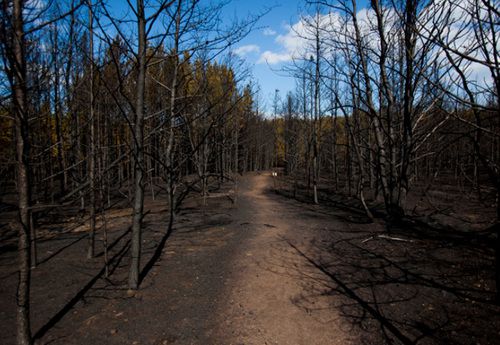Being a city slicker far away from the BWCA fire, it’s hard for me to know what the overwhelming sentiment is about the way firefighting efforts there are being handled. Clearly there are two schools of thought on it as evidenced by some of the heartfelt reaction we’re getting to our coverage.
Yesterday, MPR’s Cathy Wurzer talked about the ecology of the fire with Lee Frelich of the University of Minnesota, who noted that there’s not even 20/20 hindsight on this issue:
But a reader from Ely – I don’t have permission to use her name, so I won’t until I do – responds:
I want to know how many of our struggling moose population died in that fire, in prime moose country. (The moose-hunting season needs to stop, in order to preserve the bloodlines of healthy animals that have genetically begun to cope). How many thousands of other animals unable to escape the fire perished in agony, and what will that do to their populations?
White pine “virtually exterminated” on the Gunflint after the Ham Lake fire – that’s what happens now when fire burns with such unnatural intensity, burning everything including the big pine because of all the fuel. At one time fires burned under the big trees and kept the forest floor relatively clear – before indiscriminate logging – when it was pine and woodland caribou country. White and Norway pine are more important than to deserve such a blasé attitude – “unfortunately” is an understatement. What’s coming back on the Gunflint is basically a forest obliterated. So will it be after the Pagami Creek fire.
Because of what was done in the name of progress we only have remnants of a forested lake country that slowly evolved over hundreds of years. We unnaturally changed that evolution in one century. Yet we have such a ‘disconnect’ that we believe we are now letting nature take its course as it always has with fire – never recognizing that we completely changed that course in one fell swoop.
One tenth of the Boundary Waters gone is not a “mosaic” forest – mosaics are many small pieces – not ten giant ones. Nine more fires like this one (less because of the Gunflint fires) and the BWCAW will be devastated for generations. We must speak up now and say this is a forest that needs a unique kind of fire fighting mentality – not just let it burn – but rather protect the diversity of the BWCAW by putting fires out when appropriate. Don’t gamble again on not having strong winds with the fire danger at high. Get back to a Forest Service that is in the field every day, not monitoring the forest from behind a desk.
Bill Hansen, who owns Sawbill Outfitters in the BWCA, addresses the firefighting efforts on Boreal Access:
I know that they will receive criticism about their management of the Pagami Lake fire, but I feel like that criticism is somewhat unfair. For more that 30 years we have all understood that fire is a normal part of the ecosystem here in the northern forest region. Historically, every acre of this forest burned at least once every 70 years. After European settlement and the establishment of the timber industry, the Forest Service was charged with aggressively extinguishing every wild fire, no matter what the cause. The forest managers got pretty good at fire suppression over the years. Over time, scientists came to realize that the policy of suppressing all fires was just setting the stage for disastrous, destructive fires, which since 1988 have been referred to as “Yellowstone” type fires. Now there is no longer any doubt that fire must be allowed on the landscape, or the forest as we know it will eventually cease to exist. Over the last 20 years or so, forest managers have developed a much smarter, nuanced approach to how they manage fire. They have been remarkably successful with this new approach and have made a lot of progress, especially in the wilderness, toward their goal of maintaining a healthy forest eco-system. That said, fire management often hinges on accurately predicting the weather, which carries an inherent risk. I think the Forest Service does a remarkable job with fire, but they are only human and nature will occasionally humble any human, no matter how skilled. I would urge the critics to look at the big picture, learn as much as possible about fire policy, and remember that hindsight is 20-20 and it’s much easier to judge the future once it has passed. Since I had my first conversation with legendary fire ecologist Bud Hinsleman, I’ve known that wildfire in this part of the world isn’t a matter of “if”, it’s just a matter of “when.”
The fire in the BWCA may burn for weeks. It will be long put out before there’s any agreement on how.

